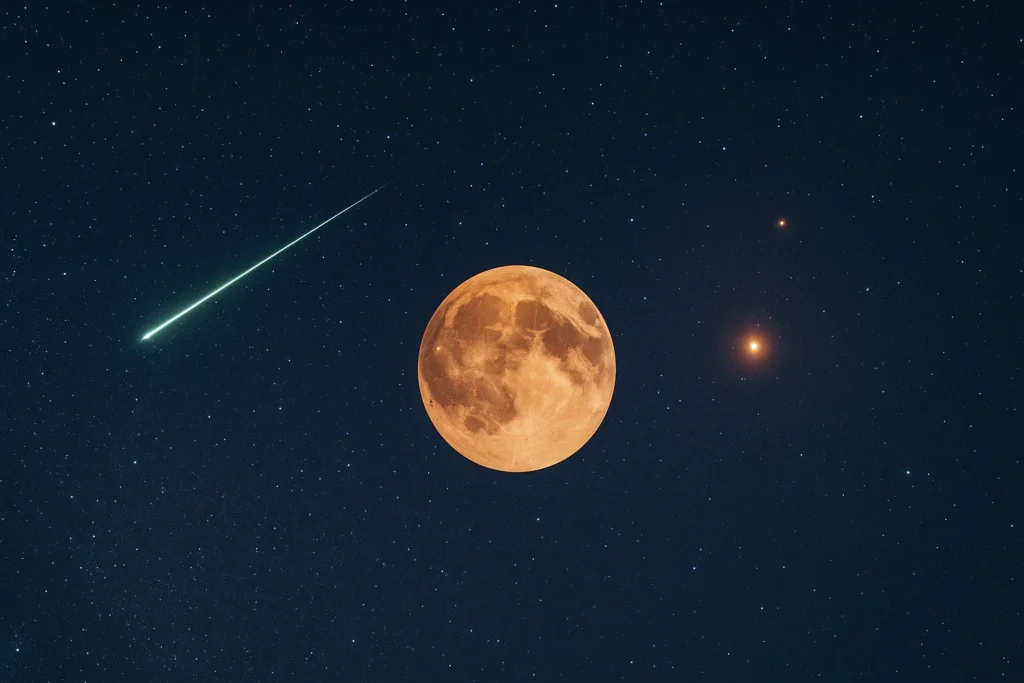Introduction: The Universe’s Summer Invitation
Imagine stepping outside as twilight fades, looking up, and seeing the night sky transform into a grand theater. This June, the cosmos is putting on an extraordinary show, inviting us all to witness a series of dazzling celestial events. From streaking meteors that light up the pre-dawn darkness to a full moon named after summer’s sweet bounty, and a rare dance between Earth’s closest cosmic neighbors, this month is a stargazer’s delight.
Whether you’re a seasoned astronomer with a powerful telescope or simply someone who enjoys looking up at the stars, June offers accessible and breathtaking phenomena. It’s a reminder of the vast, intricate beauty of our universe and our place within it. So, get ready to set your alarms, find a clear spot, and prepare to be amazed. Let’s explore the celestial highlights that await us this month.
Dawn’s Dust Trails: The Arietid Meteor Shower
As June begins, early risers are in for a special treat: the Arietid meteor shower. While not as famous as the Perseids or Geminids, the Arietids are known for being one of the strongest daytime meteor showers, meaning their peak activity happens when the sun is up. This makes them a unique challenge, but also a rewarding sight for dedicated observers.
What are the Arietids?
Meteor showers occur when Earth passes through trails of dust and debris left behind by comets or asteroids. As these tiny particles enter Earth’s atmosphere, they burn up, creating bright streaks of light we call meteors or “shooting stars.” The Arietids are believed to originate from the asteroid 1566 Icarus, though some theories suggest a comet, such as 96P/Machholz, might also contribute.
Viewing the Elusive Streaks
The peak of the Arietid meteor shower is expected around June 7. Because they are a “daytime” shower, spotting them requires a specific approach:
- When to Look: The best chance to see them is in the pre-dawn hours, just before sunrise. The radiant (the point from which they appear to originate) is in the constellation Aries, which will be rising in the east at this time.
- Why Pre-Dawn? During these hours, the sky is still dark enough for brighter meteors to be visible, even though the shower’s peak is technically during daylight.
- Challenges: The strong daylight often washes out most of the meteors, making them difficult to spot without specialized radio equipment. However, brighter “Earthgrazers” – meteors that skim through the atmosphere – might be visible if you are very lucky and have a clear, dark eastern horizon.
- No Equipment Needed: Like all meteor showers, no special equipment is required. Just your eyes, patience, and a comfortable spot to lie down and look up.
Even if you don’t spot a shower of meteors, the quiet beauty of the pre-dawn sky is a reward in itself, offering a peaceful start to the day.
June’s Luminous Orb: The Strawberry Moon
Mid-June brings one of the most beloved celestial sights: a full moon. This month, it’s known as the Strawberry Moon, a name that evokes the warmth and bounty of early summer. The Strawberry Moon will grace our skies around June 11.
The Story Behind the Name
The names for full moons often come from Native American, Colonial American, or European traditions, reflecting natural events or agricultural activities common during that month. The name “Strawberry Moon” doesn’t mean the Moon will appear red or pink. Instead, it was given by Algonquin tribes and and other Native American groups because it marked the peak season for harvesting wild strawberries in North America.
Other names for the June full moon include:
- Rose Moon: From Europe, referring to the blooming of roses.
- Hot Moon: Indicating the beginning of summer’s heat.
- Mead Moon: As it was the time for cutting hay and making mead.
How to Enjoy the Full Moon
The full moon is visible to the naked eye and is generally an easy object to observe.
- When to Look: The Moon will appear full for about three days centered around June 11. It’s often most striking when it rises in the east just after sunset, appearing larger and sometimes with a reddish or orange hue due to atmospheric scattering of light.
- No Special Equipment: Your eyes are all you need. Binoculars can offer a closer look at the Moon’s craters and surface features, but they aren’t necessary for enjoying its full splendor.
- Find a Clear View: Look for a spot with a clear view of the eastern horizon at sunset, or simply observe it throughout the night as it climbs higher in the sky.
The Strawberry Moon serves as a gentle reminder of nature’s cycles and the changing seasons, a brilliant beacon in the early summer night.
A Cosmic Dance: Moon and Mars in Close Encounter
As June draws to a close, the night sky offers another captivating event: a close encounter, or conjunction, between our familiar Moon and the fiery red planet, Mars. On June 30, these two celestial bodies will appear remarkably close together in the sky, creating a beautiful pairing for observers.
What is a Conjunction?
A conjunction in astronomy simply means that two or more celestial objects appear close together in the sky as viewed from Earth. It’s important to remember that they are still millions of miles apart in actual space; it’s an illusion of perspective.
Spotting the Red Planet and Its Companion
Finding Mars in the night sky is usually quite straightforward due to its distinctive reddish hue. Its pairing with the Moon on June 30 will make it even easier:
- When and Where to Look: On the evening of June 30, look towards the western sky after sunset. The Moon will be a waxing crescent, making it even more charming alongside Mars. Mars will appear as a bright, reddish point of light very close to the Moon.
- Identifying Mars: Unlike stars that twinkle, planets tend to shine with a steady light. Mars is famously red, a color that makes it stand out against the backdrop of other stars.
- Telescope or Binoculars (Optional): While visible to the naked eye, a pair of binoculars will offer a clearer view of both objects. A telescope, even a small one, might reveal some surface details on Mars if atmospheric conditions are good.
This Moon and Mars conjunction is a wonderful opportunity to introduce yourself to planetary viewing, showcasing the dynamic movements of objects within our own solar system.
Tips for the Aspiring Stargazer: Making the Most of June’s Sky
To truly enjoy June’s celestial spectacles, a little preparation can go a long way. You don’t need expensive equipment to appreciate the night sky, but a few simple tips can enhance your experience.
Your Essential Stargazing Toolkit
- Find a Dark Spot: The biggest enemy of stargazing is light pollution. Try to get away from city lights, if possible, to an area with minimal artificial brightness. Even a local park or backyard can offer decent views if city lights aren’t too overwhelming.
- Check the Weather: Clear skies are a must. Cloud cover will obstruct your view.
- Allow Your Eyes to Adjust: It takes about 20-30 minutes for your eyes to fully adapt to the darkness. Avoid looking at bright phone screens during this time. If you need light, use a red-light flashlight, as red light is less disruptive to night vision.
- Patience is Key: Especially for meteor showers, you’ll need to be patient. Lie down on a blanket or in a reclining chair to get a comfortable view of the entire sky.
- Dress Appropriately: Even on summer nights, temperatures can drop. Bring a jacket or blanket.
- Use Stargazing Apps: Many free smartphone apps can help you identify constellations, planets, and other celestial objects. Just remember to use them sparingly or with a red filter to protect your night vision.
By following these simple steps, you can transform a regular night into an unforgettable cosmic adventure, connecting with the vastness of the universe from your own backyard.
Conclusion: June’s Cosmic Gift
This June, the universe is offering a remarkable series of celestial events, transforming our night (and pre-dawn) skies into a captivating canvas. From the elusive streaks of the Arietid meteor shower on June 7, to the gentle glow of the Strawberry Moon on June 11, and the charming cosmic embrace of the Moon and Mars conjunction on June 30, there’s something for every sky-gazer.
These phenomena remind us of the continuous, majestic dance happening far above our heads. They are more than just scientific occurrences; they are moments of wonder that connect us to something much larger than ourselves. So, take the opportunity this month. Look up. Let the universe amaze you, and carry that sense of cosmic wonder with you long after June’s dazzling sky show has faded. The stars await.



